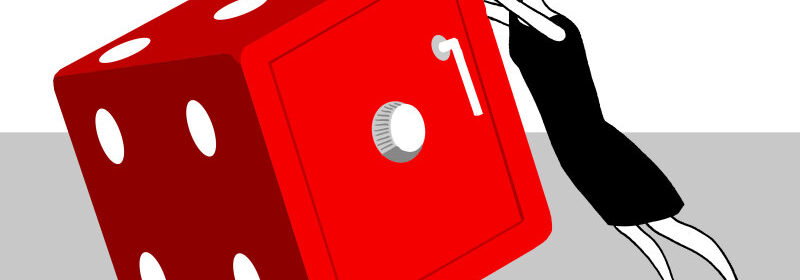Think real estate is a ‘safe’ investment? Actually, there’s no such thing

Save articles for later
Add articles to your saved list and come back to them any time.
“I’m scared to invest because I heard it’s risky.” Over the years I’ve often heard variations on this statement. By now, I’ve come to the conclusion that risk is one of the most poorly understood concepts in personal finance.
Often, people think they’re talking about risk but actually, they’re talking about fear. They’re scared to invest, lose money or make the wrong decision.
Risk is one of the most poorly understood concepts in personal finance. There’s no such thing as a sure bet.Credit: Simon Letch
The fear is based on what they’ve been conditioned to believe – from friends and family, the media, broader society, or even their own past personal experiences. For example, many assume buying a property is safe but investing in shares is risky. Many assume having a job is safe but starting a business is risky.
But risk isn’t so black-and-white.
It’s rarely the case that something is either risky or it’s not. It’s usually the case that there are different risks associated with a particular decision or activity.
This failure to understand risk properly comes at a big cost because it leads to poor decisions and lost opportunities – avoiding or delaying investing, selecting inappropriate investing options assuming they’re “safer”, panic selling when the market drops and so on.
Instead of being the enemy, risk can, in fact, be our financial friend.
So, today I want to unpack some of the common misconceptions around risk:
1. “Real estate is a safe investment.” Let’s start with this: there is no such thing as a safe investment.
Think about what safe even means in this context. Does it mean that there’s no chance of losing money? Does it mean that you’re guaranteed to get a return? Neither of those things apply to real estate.
Firstly, we need to understand how risk and return relate to each other. Generally, lower-risk investment options will come with a lower opportunity for return.
If you think about cash or term deposits: the risk of losing money is lower than other options (but you can still lose money to inflation), but the potential return will also be lower.
For starters, this means that maybe you shouldn’t be looking for a safe investment in the first place because it may not deliver the level of return you need to achieve your goals.
But also, on that risk-return spectrum, real estate is not considered a low-risk investment.
Think about all the various elements of risk involved in real estate. You take out a large loan. That’s a risk. It’s harder to diversify, so you’ll have a lot of eggs in one basket. That’s a risk. Will your specific property perform well? That’s a risk.
If you don’t know what you’re doing, it absolutely is possible to lose money in real estate.
2. “Investing in shares is risky.” This statement makes it sound as though the alternative options are not risky, when the truth is – everything has risks associated with it.
Keeping cash in your bank has risks, real estate or term deposits have risks – there isn’t a risk-free investing option out there (and if anyone is telling you otherwise, that’s a red flag).
This sentiment also ignores the fact that today, there are lower-risk options for getting exposure to share market returns.
Not too long ago, if you wanted to invest in the share market you generally had to invest in a specific company. Today, you can invest in an ETF, which gives you exposure to a whole basket of companies instantly, giving you the benefit of automatic diversification. So, you don’t have to pin your hopes on a single (or even handful) of companies.
The other variable that this statement ignores is the investor themself. It’s not just the activity of investing, or the investment product, that carries risk. The investor – their skills, decision-making abilities, emotional staying-power – also adds to the risk.
While you may hear stories about people losing money in investments, what you often don’t hear is how their decisions or behaviours may have contributed to that loss.
Did they try to jump onto a hot investment fad? Were they day-trading? Did they panic and sell? Or did they fail to rebalance their portfolio to be more suitable for their risk profile?
These are all risks that the investor has the direct ability to influence and manage. When investing, the amount of risk you are exposed to isn’t totally fixed – there are ways to manage and reduce your risk exposure, and that’s up to you as the investor.
So, what if we changed the narrative on risk? What if we decided that instead of being something to fear and avoid, we chose to start viewing risk as something to understand and manage?
Risk isn’t something that is threatening to take our money away. With a bit of understanding, risk can be something we can learn to use to accelerate the growth of our wealth.
Instead of being the enemy, risk can, in fact, be our financial friend.
Paridhi Jain is the founder of SkilledSmart, which helps adults learn to manage, save and invest their money through financial education courses and classes.
- Advice given in this article is general in nature and is not intended to influence readers’ decisions about investing or financial products. They should always seek their own professional advice that takes into account their own personal circumstances before making any financial decisions.
For expert tips on how to save, invest and make the most of your money, delivered to your inbox every Sunday, sign up for our Real Money newsletter here.
Most Viewed in Money
From our partners
Source: Read Full Article

